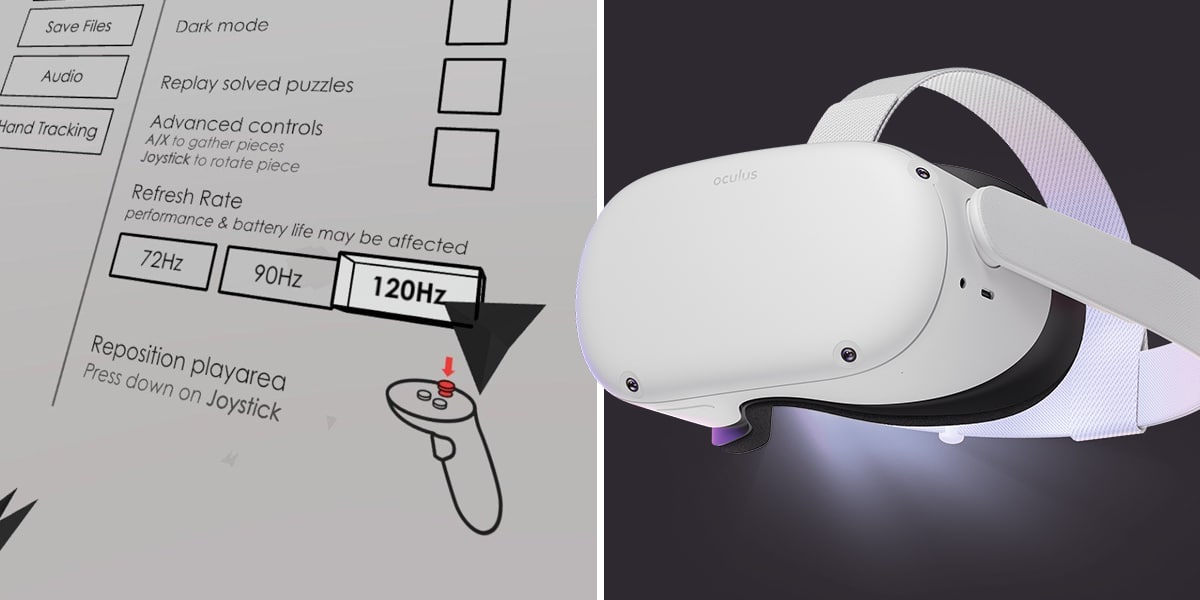A recent study concluded that 120fps is the “important threshold” to avoid VR sickness for most people.
There are two kinds of sickness in VR. One is caused by content – many people feel sick when moving in VR, such as through thumbstick locomotion, while not moving in real life. The other is caused by imperfect hardware. Flaws in optics, tracking, rendering, and other core tech can also make people feel sick. These study was concerned with the latter type.
The paper comes from Xi’an Jiaotong–Liverpool University in China, where the authors have been studying the effects of VR refresh rates, resolution, haptics, stereoscopy, and more for years, including how these elements all relate to simulator sickness.
A Pimax 5K Super was used for the study, because it supports up to 180Hz refresh rate which is the highest of any headset on the market.
The study tested 60fps, 90fps, 120fps, and 180fps to compare their effect on sickness for the 32 participants, 16 male and 16 female, aged between 18 and 51.
It found that 120fps is the “important threshold” after which the participants reported significantly reduced nausea compared to 60fps and 90fps. At 180fps the reduction in nausea was minimal, suggesting 120fps is the threshold.
It’s important to note that this study was confined to one niche headset, so it’s unknown whether its results generalize to other headsets. The Pimax 5K Super has a significantly wider field of view than typical VR headsets, for example, with geometric distortion throughout the periphery. Past research has indicated that field of view and geometric distortion can both affect sickness.
| Headset | Supported Refresh Rates (Hz) |
| Apple Vision Pro | 90 / 96 / 100 |
| Quest 2 | 60 / 72 / 80 / 90 / 120 |
| Quest 3 | 60 / 72 / 80 / 90 / 120 |
| Pico 4 | 72 / 90 |
| PlayStation VR2 | 90 / 120 |
| Valve Index | 72 / 80 / 90 / 120 / 144 |
| Pimax 5K Super | 90 / 120 / 144 / 180 |
| Pimax Crystal | 72 / 90 / 120 |
Quest 3 and Quest 2 do support 120Hz refresh rate. But in standalone mode it’s a developer-side option that very few use, because the requirement to render each frame in just 8 milliseconds severely limits graphical fidelity and simulation complexity on mobile chipsets.
Most titles run at the default 72Hz on Quest 2, while many have implemented an upgrade to 90Hz on the newer Quest 3. It will be a long time until 120Hz is the standard in standalone VR.
Every Game That Supports 120Hz On Oculus Quest 2
With the v28 software update, Oculus Quest 2 now has experimental support for a 120Hz refresh rate. Here’s every Oculus Store game that can run at 120Hz on Quest 2 (so far). The Quest 2 shipped last year with just a 72Hz refresh rate — the same as the original

On PC rendering at 120FPS is achievable with most graphics cards in simple titles such as Beat Saber, but requires extremely expensive high-end hardware for more complex experiences such as flight and racing simulators. Valve Index even supports a 144Hz mode, and the Pimax 5K Plus used in the study supports 180Hz.
Significantly complicating the matter of frame rate though is reprojection and motion extrapolation, which double the true frame rate by generating synthetic intermediary frames. This is very common on PlayStation VR2, where many games render at 60fps to be reprojected to 120fps for display at 120Hz. On Quest this is a developer-side option too, but only used in a handful of titles such as Assassin’s Creed Nexus, while on PC it’s a compositor-side feature that kicks in when your graphics card is under too much load.
While it’s unknown whether this study’s results apply to all headsets, it’s nonetheless an interesting result that suggests the industry shouldn’t settle for even the 90fps standard established at the launch of the Oculus Rift and HTC Vive, nevermind the 72fps popularised by standalone headsets like Oculus Quest. Just as resolution is pushing forward so should frame rate, to ensure headsets make as few people sick as possible.
- SEO Powered Content & PR Distribution. Get Amplified Today.
- PlatoData.Network Vertical Generative Ai. Empower Yourself. Access Here.
- PlatoAiStream. Web3 Intelligence. Knowledge Amplified. Access Here.
- PlatoESG. Carbon, CleanTech, Energy, Environment, Solar, Waste Management. Access Here.
- PlatoHealth. Biotech and Clinical Trials Intelligence. Access Here.
- Source: https://www.uploadvr.com/study-120fps-important-to-avoid-sickness/



